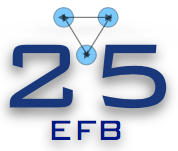Speaker
Description
Rare Isotope Beam (RIB) facilities provide a unique opportunity to investigate the structures and reactions of atomic nuclei near the drip line. Experiments have observed that some light nuclei with excess neutron or proton numbers exhibit a molecular-like structure consisting of a tightly bound core surrounded by a few loosely bound halo nucleons referred to as halo nuclei. The stability of these structures and their corresponding reaction mechanism play significant roles in the generation of nuclei in astrophysical environments.
The combination of effective field theory (EFT) with nuclear cluster models provides an excellent description of the structure and reaction of halo nuclei. This theory describes halo nuclei in effective core and halo-nucleon degrees of freedom, with interactions among each cluster represented by a series of contact interactions. Sharing similar formalism with the pionless EFT, the halo EFT allows for the analysis of renormalization in non-perturbative regimes, unveils novel near-threshold features in halo nuclei, and allows a model-independent systematic improvement of theoretical accuracies.
We introduce the foundations of halo EFT and its application in describing halo nuclei structures, photo-induced fragmentation reactions, neutron capture reactions, and other nuclear reaction processes [1]. A novel power counting approach has been developed in our recent work to describe shallow P-wave resonances using nonlocal momentum-dependent contact interactions [2]. This method has been applied to the $^6$He system consisting of two neutrons and an alpha particle, accurately reproducing the neutron-alpha elastic scattering phase shift near the $^5$He P-wave resonance as well as displaying the same renormalizability feature in calculating the $^6$He bound state as the energy-dependent interaction formalism [3,4].
Furthermore, the formalism has been extended to study the doubly virtual Compton scattering process in deuteron. This study is critical for calculating the two-photon-exchange nuclear-structure corrections to the atomic spectrum in both electronic and muonic deuterium [5]. Combined with accurate spectroscopy measurements, the two-photon exchange calculation is instrumental for high-precision determination of nuclear charge and magnetic radii.
[1] H.W. Hammer, C. Ji and D.R. Phllips, J.Phys. G 44, 103002 (2017).
[2] Q. Li, S. Lyu, C. Ji and B. Long, arXiv:2303.17292 [nucl-th].
[3] M. Gobel, H.W. Hammer, C. Ji and D.R. Phillips, Few Body Syst. 60, 61 (2019).
[4] C. Ji, C. Elster and D.R. Phillips,Phys. Rev. C 90, 044004 (2014).
[5] S.B. Emmons, C. Ji and L. Platter, J. Phys. G 48, 035101 (2021).

